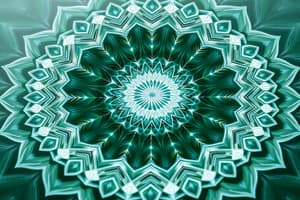Podcast
Questions and Answers
What is defined as patterns in nature that can be mathematically modeled?
What is defined as patterns in nature that can be mathematically modeled?
- Textures
- Colors
- Shapes
- Symmetries (correct)
Which type of symmetry is characterized by reflectional properties?
Which type of symmetry is characterized by reflectional properties?
- Rotational symmetry
- Bilateral symmetry (correct)
- Six-fold symmetry
- Fivefold symmetry
Which type of symmetry is not found in true crystals?
Which type of symmetry is not found in true crystals?
- Cubic symmetry
- Hexagonal symmetry
- Fivefold symmetry (correct)
- Octahedral symmetry
What is the primary reason for studying patterns in living organisms?
What is the primary reason for studying patterns in living organisms?
What type of symmetry can be observed in the crown-shaped splash pattern formed by a drop of water?
What type of symmetry can be observed in the crown-shaped splash pattern formed by a drop of water?
Which of the following is NOT a type of pattern mentioned in nature?
Which of the following is NOT a type of pattern mentioned in nature?
In which groups is fivefold symmetry predominantly found?
In which groups is fivefold symmetry predominantly found?
What mathematical concept can explain the patterns formed during crystallization?
What mathematical concept can explain the patterns formed during crystallization?
What is the characteristic feature of fractals?
What is the characteristic feature of fractals?
Which of the following best describes spirals?
Which of the following best describes spirals?
What is the primary function of stripes in animals?
What is the primary function of stripes in animals?
How many wallpaper groups of tessellations exist?
How many wallpaper groups of tessellations exist?
What is the smallest possible surface area for a given volume in bubble formation?
What is the smallest possible surface area for a given volume in bubble formation?
What does the pattern of cracks in materials indicate?
What does the pattern of cracks in materials indicate?
What is the rule identified in the Fibonacci sequence example provided?
What is the rule identified in the Fibonacci sequence example provided?
In the sequence 1, 10, 100, 1000,... what will be the 6th term?
In the sequence 1, 10, 100, 1000,... what will be the 6th term?
What is the 7th term in the Fibonacci sequence?
What is the 7th term in the Fibonacci sequence?
Which of the following correctly represents the rule for the Fibonacci sequence?
Which of the following correctly represents the rule for the Fibonacci sequence?
What is the value of the 8th term in the Fibonacci sequence?
What is the value of the 8th term in the Fibonacci sequence?
Which of the following statements accurately describes the pattern observed in multiples according to the provided information?
Which of the following statements accurately describes the pattern observed in multiples according to the provided information?
In the Fibonacci sequence, what is the sum of the 6th and 7th terms?
In the Fibonacci sequence, what is the sum of the 6th and 7th terms?
How does the Fibonacci sequence relate to patterns in nature?
How does the Fibonacci sequence relate to patterns in nature?
What is the first number that is a multiple of 5 in the described sequence of every 5th number?
What is the first number that is a multiple of 5 in the described sequence of every 5th number?
If you continue the described spiral to find the Fibonacci sequence, what is the 30th Fibonacci number?
If you continue the described spiral to find the Fibonacci sequence, what is the 30th Fibonacci number?
If a Fibonacci sequence starts with 0 and 1, what will be the next four terms?
If a Fibonacci sequence starts with 0 and 1, what will be the next four terms?
What pattern is shown by the Fibonacci sequence when represented graphically?
What pattern is shown by the Fibonacci sequence when represented graphically?
Based on the information given about n, which description is correct regarding multiples?
Based on the information given about n, which description is correct regarding multiples?
What is the correct continuation of the pattern observed with X=3, X=4 and X=5?
What is the correct continuation of the pattern observed with X=3, X=4 and X=5?
What is the term number for the value 144 in the Fibonacci sequence?
What is the term number for the value 144 in the Fibonacci sequence?
Study Notes
Chapter 1: Nature of Mathematics
Objectives
- Identify and differentiate patterns in nature.
- Understand the Fibonacci sequence.
- Appreciate the beauty of mathematics through patterns and numbers in nature and the world.
Patterns in Nature
- Visible regular forms found throughout the natural world.
- Can be modeled mathematically, including types like symmetries, spirals, etc.
- Represent underlying biological processes in living organisms.
- Computer models are utilized to simulate a variety of patterns.
Types of Patterns
-
Symmetry: Balanced proportions where different sides are alike.
- Bilateral Symmetry: Reflectional symmetry; figures remain unchanged upon reflection.
- Rotational Symmetry: Pattern remains unchanged when rotated (e.g., splash patterns, planet rings).
- Fivefold Symmetry: Found in echinoderms like starfish; reason behind this symmetry is unclear.
- Sixfold Symmetry: Common in snowflakes, mirroring growth patterns on each arm.
-
Fractals: Infinite self-similar patterns; nature only approximates these due to limitations in iteration.
-
Spirals: Curves increasing in distance from a central point as they revolve around it.
-
Tessellations: Repeating tiled patterns covering flat surfaces; 17 wallpaper groups exist.
-
Bubbles/Foams: Soap bubbles form spheres with minimal surface area, optimizing volume.
-
Stripes: Patterns often explained by evolutionary functions helping offspring survival.
-
Cracks: Linear patterns forming in materials to relieve stress, indicating elasticity.
Fibonacci Sequence
- An ordered list of numbers where each term is the sum of the two preceding terms.
- Starts with 0, 1: 0, 1, 1, 2, 3, 5, 8, 13, 21, 34, ...
Key Features of Fibonacci Sequence
- Terms are indexed starting from 0.
- Rule: X_n = X_(n-1) + X_(n-2)
- Patterns observed in nature with Fibonacci numbers, such as the arrangement of leaves, flowers, and fruits.
Notable Patterns within Fibonacci Sequence
- Every third number (2, 8, 34, ...) is a multiple of 2.
- Every fourth number (3, 21, 144, ...) is a multiple of 3.
- Every fifth number (5, 55, 610, ...) is a multiple of 5.
Activities
- Capture the Beauty of Mathematics: Identify and document at least 10 patterns found in the environment.
- Fill the Spiral: Extend the Fibonacci sequence to term number 30 by finding and writing the subsequent numbers.
Studying That Suits You
Use AI to generate personalized quizzes and flashcards to suit your learning preferences.
Description
Explore the fascinating nature of mathematics in this first chapter of the module. Gain insight into patterns found in nature and the significance of the Fibonacci sequence. Appreciate the beauty of mathematics as it connects to the world around us.




